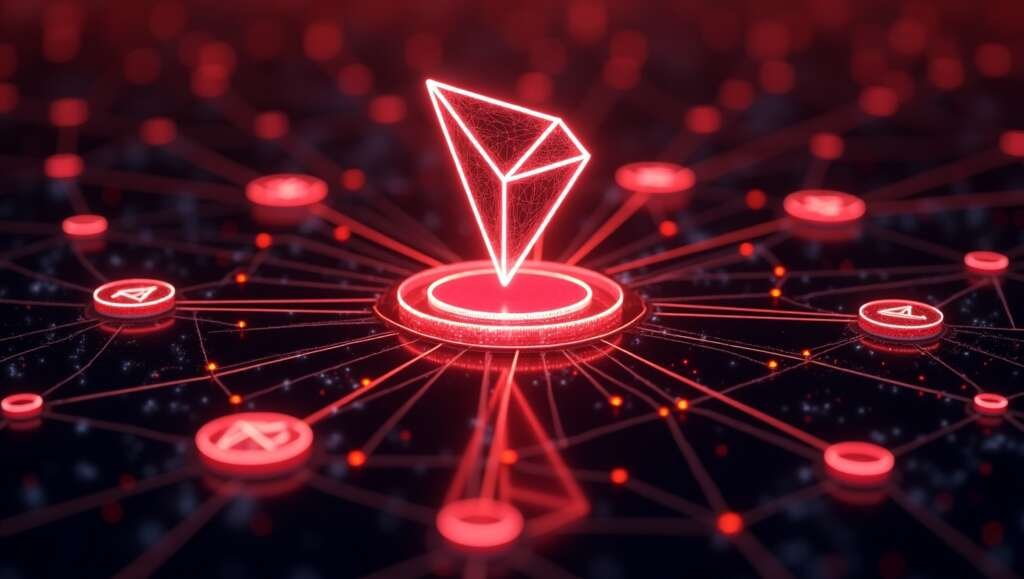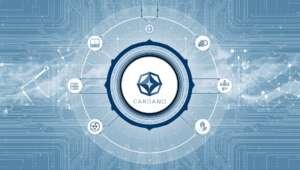In recent years, blockchain technology has emerged as one of the most important innovations in the global digital economy. There are many blockchain protocols competing for relevance and adoption. Tron stands out as a network that has continuously positioned itself as a fast, low-cost, and user-friendly alternative to many existing blockchains. Its native currency, TRX, is widely used not only within the TRX ecosystem but also as a tradable asset on crypto exchanges and trading platforms across the world.
Tron was launched in 2017 by Justin Sun, with a clear focus on usability and accessibility. The technical framework is focused on high transaction throughput, lower transaction fees, and smart contracts, which makes it attractive for developers creating decentralized applications (dApps). Tron is one of the most influential networks in the evolution of the digital economy.
Background and History
Tron was founded in 2017 by Justin Sun, a Chinese entrepreneur who has made a remarkable contribution to the blockchain industry. The development of the Tron ecosystem began with an Initial Coin Offering (ICO) on the Ethereum blockchain to raise necessary funds through token sales. With the necessary funding in place, Tron eventually launched its own fully operational blockchain.
In 2018, one of the most important milestones in Tron’s history was its acquisition of BitTorrent, a peer-to-peer file sharing service with millions of users. The acquisition provided Tron with the necessary technology as well as a ready user base, proving that the project is willing to merge blockchain with client-facing internet services.
In 2021, Tron formally transitioned towards community-led governance by creating a Decentralized Autonomous Organization (DAO) called the Tron DAO. This was designed to impart decision-making power to token holders. This major transition marked Tron’s attempt to rebrand itself as a community-based ecosystem, which is far from centralized leadership.
Tron’s Mission
“Decentralize the web,” this is the core mission of Tron . Its aim was to create a digital environment where people can share content, run applications, and exchange value without depending on big companies or intermediaries that may charge high fees.
As we all know, there are many large platforms on the internet for streaming services, social media networks, and apps. But the drawback of these platforms is that they control what gets published, which means they wield the power to decide who earns money and the amount that creators are paid. But Tron’s vision posed a challenge to this model by giving people the full freedom to own their content, control their data, and get rewards directly from users.
Tron made a statement that people can send and receive tokens quickly and at low cost. Smart contracts are executed safely without the need for a central authority. Decentralized applications can operate directly by cutting intermediaries between creators and users.
It means, if a content creator or game developer could share their work on Tron, they get paid instantly in TRX and retain full control. All these processes are happening without the need to rely on other platforms to handle payment or distribution.
How does Tron work?
Tron incorporates a combination of Delegated Proof of Stake (DPoS) consensus-based blockchain infrastructure with smart contract capabilities and Super Representatives (SR) to offer fast, low-cost tokenization standards. Unlike conventional consensus mechanisms, where every validator competes to create blocks, a small group of trusted participants, referred to as SRs, takes up the responsibility of creating blocks and validating transactions. With a maximum of twenty-seven SRs active at a time, this arrangement makes the network faster and cheaper.
Tron is designed for speed, with a new block created every three seconds compared to Ethereum’s twelve-second and Bitcoin’s ten-minute block times. This allows the transactions to be confirmed quickly, which, combined with low transaction costs, makes Tron ideal for everyday crypto transactions as well as for dApps handling high transaction volumes, among other services.
Tron Virtual Machine (TVM) is the runtime environment for smart contracts on the Tron Network. It shares similarities with EVM (Ethereum Virtual Machine), making the blockchain EVM-compatible, allowing developers to seamlessly host or migrate their dApps on Ethereum to Tron as well.
Like Ethereum has ERC tokens, Tron also has its own token standards known as TRC Tokens. The basic tokens are simple, cheap, and easy to create, such as TRC-10 and TRC-20 tokens, which are smart contract-based tokens widely used by stablecoin issuers and as digital assets.
What is TRX, and how is it used?
Tronix (TRX) is a native token on the Tron protocol. It is the foundation of the entire ecosystem, functioning as the medium of value and information exchange. Be it sending funds, executing smart contracts, or performing other functions, TRX plays a critical role in every single transaction happening on the Tron network.
Tron was launched with a circulating supply of 100 billion TRX. However, the number of tokens in circulation has fluctuated ever since, due to various functions like staking, treasury allocations and other adjustments. At present, anywhere between 90 and 95 billion TRX is in active circulation.
The Tron network includes a TRX freezing mechanism that allows users to lock the asset to earn two types of network resources — Bandwidth and Energy. The Bandwidth earned can be used to save transaction fees, whereas the Energy can be used to save TRX costs on smart contract interactions.
The feature of TRX is its freezing mechanism, where holders can freeze their tokens in order to gain two types of network resources and earn voting power. Freezing is how the community votes for SRs, and those supporting the SRs involved in generating a new block and validating transactions will receive a share in the rewards.
Tron has also introduced a deflationary mechanism, which is designed to gradually reduce the token supply. These include burning a portion of transaction fees, periodic buybacks, and organized token burn events, which are announced by Tron DAO or the development team. These actions remove TRX from circulation, creating supply pressure. The burn mechanism can create a long-term scarcity effect. They provide up-to-date figures that are typically reported by the exchange through Tron’s official channels.
Tron Governance
Governance on Tron is structured between Super Representatives (SRs) and the broad community through the Tron DAO. This dual framework is designed to maintain efficiency in network operations while allowing the community to influence the direction of the ecosystem’s development.
Super Representatives (SRs) are the active network operators elected by token holders to maintain the network, validate transactions, and produce new blocks. SRs are rewarded in TRX for their service, creating a strong economic incentive to perform. The limited set of SRs responsible for transaction validation, combined with quick block times and DPoS consensus mechanisms, makes Tron ideal for high-volume applications.
As mentioned earlier, the Tron DAO model enables the community to submit proposals and vote on protocol upgrades. Proposals may include adjustments to block rewards, treasury allocations, or even changes to economic policies like burn schedules. Voting power is directly linked to staked TRX, which means that larger stakeholders have greater influence. This ensures that Tron has a strong voice; it also means governance power can be concentrated among large token holders and exchanges.
The Tron governance model ultimately depends on how engaged the community remains, which means that if the token holders are active and have more engagement, it makes decision-making more transparent.
Who uses Tron for what?
One of Tron’s greatest strengths is its practical applications. The low cost, speed and scalability of Tron find practical application in payments and remittances. As a result, Tron has become the preferred network to send stablecoins like USDT, helping it gain a strong foothold in the crypto space.
The Tron ecosystem is widely accepted across the industry, with almost all centralized as well as decentralized exchanges supporting Tron-based assets. At the time when Ethereum gas fees were at an all-time high, traders chose to transact the supported multichain assets on the Tron blockchain rather than the Ethereum chain, which led to its initial popularity.
Today, Tron has a thriving DeFi environment with many projects building their dApps on the blockchain, enabling users to deposit their TRC20 tokens to earn interest, secure loans against crypto collaterals, participate in DEX liquidity pools and more. As a result, Tron features among the top protocols in terms of TVL (Total Value Locked) on the blockchain. Meanwhile, Tron-based tokens like BTT and others also find utility on supported platforms like BitTorrent, enabling users to share and access content while earning incentives in the process.
Risk and Limitations
Tron has achieved major adoption and is positioned as a leading blockchain platform for stablecoin transactions and decentralized applications. There are certain risks too:
Technological Risk
Since Tron supports smart contracts and is EVM compatible, there is always a risk of unaudited smart contracts with security vulnerabilities hosted on the blockchain. It may lead to hacking, theft of crypto assets or permanent data loss. Another potential vulnerability is the DPoS consensus mechanism implemented by the Tron protocol. The use of a limited number of SRs to validate transactions may introduce centralization risk, making the network prone to collusion, governance capture or censorship compared to other consensus mechanisms. These technological risks could spell trouble when the network is subjected to stress by coordinated attacks on the Tron infrastructure.
Governance Risk
Tron is framed as a DAO; all token holders can participate in governance through staking and voting, but power is disproportionately concentrated among a few large stakeholders, including centralized exchanges and major TRX holders. This imbalance creates a governance risk.
Another issue is dependency on super representatives. These 27 SRs control both block production and the distribution of block rewards. If voting remains concentrated among a small set of influential participants, the SR system risks entrenching power rather than rotating it.
Moreover, actual community participation in governance remains relatively limited. While Tron’s DAO theoretically enables open decision-making, the low voter turnout often observed in protocol governance weakens the model’s effectiveness. If this happens, this may result in a governance structure that is inclusive in principle but centralized in execution.
Economic and market risk
Tron’s leading role in USDT transfer is both a strength and a risk. Overdependence on stablecoin traffic may expose Tron to systemic shocks if Tether faces legal, regulatory, or liquidity challenges.
Another economic challenge is the concentration of TRX holdings. A large share of the circulating supply is controlled by whales and centralized exchanges. This exposes to market manipulation risk and increases volatility as a major holder can influence the token price and liquidity conditions.
Regulatory Risk
Tron operates in a regulatory environment that is becoming increasingly stringent, particularly given its role as a settlement layer in stablecoin transactions. With governance and rules around anti-money laundering, KYC, and cross-border transfer, Tron faces scrutiny. If regulators impose stricter requirements, without any consideration to adoption or innovation, transaction volumes and adoption rate for Tron may be negatively impacted.
Reputational Risk
Early accusations of whitepaper issues and aggressive promotional style continue to cast a shadow on Tron’s credibility. Competitors and analysts highlight Tron’s lack of decentralisation compared to Bitcoin and Ethereum, which may affect its legitimacy in the eyes of blockchain communities. Given its low fees and fast transfers, Tron has sometimes been linked with unregulated exchanges and questionable activities. Such associations could invite reputational harm and regulatory issues.
Recent Developments
- Tron DAO continues to promote decentralization.
- Tron’s role in global USDT circulation has grown significantly.
- Reports of TRON-related corporate restrictions and potential publishing listing have risen.
- Ongoing debates continue about the long-term stability of TRON’s own stablecoin USSD.
Conclusion
Tron represents one of the most widely used blockchains in the world, particularly because of its dominance in stablecoin transactions. Its design choices, fast transaction, speed, low costs, and compatibility with Ethereum make it a practical option for developers and users; at the same time, concerns about centralization, token concentration, and governance transparency continue to challenge its reputation.


